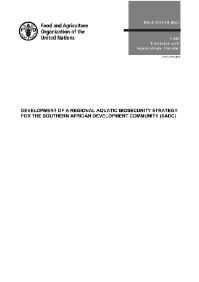Resource information
This document details the activities that were undertaken by the Food and Agriculture Organization of the United Nations (FAO) and cooperating agencies (the Department of Agriculture, Forestry and Fisheries of South Africa (DAFF), the Africa Union Inter-African Bureau for Animal Resources (AU-IBAR) and the Southern Africa Development Community (SADC)) leading to the production of a Regional Aquatic Biosecurity Strategy for the Southern African Development Community (SADC) and its subsequent adoption by SADC and incorporation into SADC programmes. These activities include: (1) assessment of national aquatic animal health performance and capacity for 14 of the 15 SADC member countries through the conducting of a Southern African Development Community (SADC) regional aquatic animal health capacity and performance survey; (2) the convening of the FAO/DAFF/AU-IBAR/SADC Regional Workshop on Improving Aquatic Animal Health Management and Strengthening Biosecurity Governance in Africa, held in Durban, South Africa, from 5–7 November 2014, with one of the specific objectives being to develop a SADC Regional Framework for an Aquatic Biosecurity Strategy; (3) the finalization of the draft Regional Aquatic Biosecurity Strategy for the Southern African Development Community (SADC) by the FAO team; (4) the submission of the strategy to the SADC Fisheries Technical Committee (April 2015) and its submission to SADC for official approval by the SADC Council of Ministers (April 2017). Included as annexes to the report are: Annex I. the Southern African Development Community (SADC) Regional aquatic animal health capacity and performance survey: Summary of survey results and analysis; Annex II. the Report of the FAO/DAFF/AU-IBAR/SADC Regional Workshop on Improving Aquatic Animal Health Management and Strengthening Biosecurity Governance in Africa; and Annex III. the Regional aquatic biosecurity strategy for the Southern African Development Community (SADC). The process was long but the most important is that it was done using a systematic approach that lead to good understanding leading to better consensus building, wide ownership and strong government commitment.


